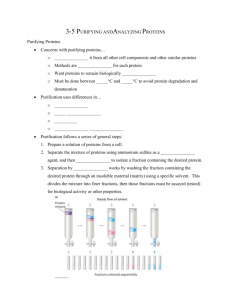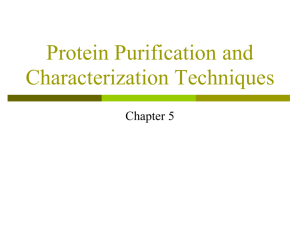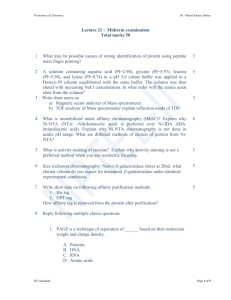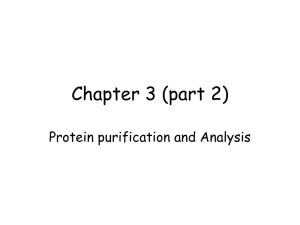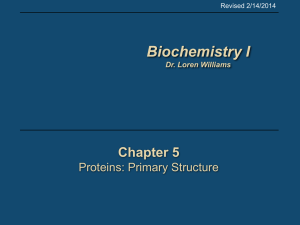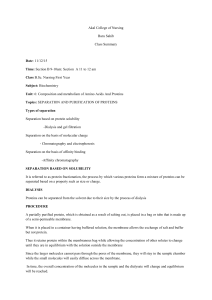Protein Purification and Characterization Techniques
advertisement
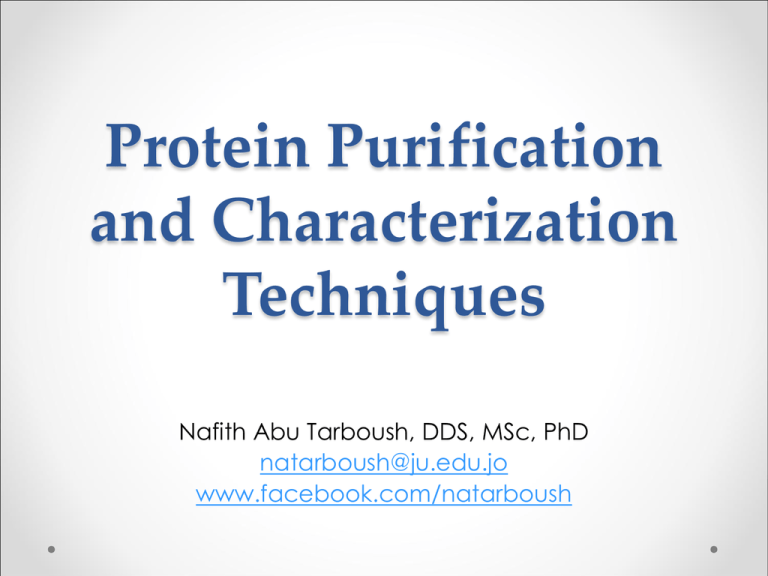
Protein Purification
and Characterization
Techniques
Nafith Abu Tarboush, DDS, MSc, PhD
natarboush@ju.edu.jo
www.facebook.com/natarboush
Extracting Pure Proteins from Cells
• Purification techniques focus mainly on size &
charge
• The first step is homogenization (grinding, Potter–
Elvejhem homogenizer, sonication, freezing and
thawing, detergents)
• Differential centrifugation (600 g: unbroken cells
& nuclei; 15,000 g: mitochondria; 100,000 g:
ribosomes and membrane fragments)
Salting in & out
• Are proteins soluble? If yes, to which limit?
• Salt stabilizes the various charged groups on a
protein molecule and enhance the polarity of
water, thus attracting protein into the solution and
enhancing the solubility of protein
• Ammonium sulfate is the most common reagent
to use at this step
• This technique is important but results are crude
Dialysis
• Principle of diffusion
• Concept of MW cut-off
• Pure vs. crude
Column Chromatography
• Greek chroma, “color,” and graphein, “to write”
• Is it just for colourful proteins?
• Chromatography is based on two phases: stationary &
mobile
• What are the different kinds?
Size-exclusion chromatography
Gel-filtration chromatography
• Separation on the basis of size (MW)
• Stationary (cross-linked gel particles): consist
of one of two kinds of polymers; the 1st is a
carb. polymer (ex. dextran or agarose);
often referred to by Sephadex and
Sepharose. The 2nd is based on
polyacrylamide (Bio-Gel)
• Extent of crosslinking & pore size (exclusion
limit)
• Convenient & MW estimate
• Each gel has range of sizes that separate
linearly with the log of the molecular weight
Molecular-sieve
chromatography
Affinity chromatography
• It has specific binding properties
• The polymer (stationary) is
covalently linked to a ligand
that binds specifically to the
desired protein
• The bound protein can be
eluted by adding high conc. of
the soluble ligand
• Protein–ligand interaction can
also be disrupted with a change
in pH or ionic strength
• Convenient & products are very
pure (Antigen-antibody, His-tag,
GST-Tag)
Ion-exchange chromatography
• Interaction based on net charge & is less specific
• Resin is either negatively charged (cation exchanger)
or positively charged (anion exchanger)
• Buffer equilibration, exchange resin is bound to counterions. A cation-exchange resin is usually bound to Na+ or
K+ ions, and an anion exchanger is usually bound to Cl–
ions
• Proteins mixture loading
• Elution (higher salt concentration)
Electrophoresis
• Based on the motion
of charged particles
in an electric field
• Macromolecules
have differing
mobilities based on
their charge, shape,
and size
• The most common
medium is a polymer
of agarose or
acrylamide
Agarose vs. PAGE
• Agarose (nucleic acids), PAGE
(proteins)
• In PAGE: SDS or NO-SDS
{CH3(CH2)10CH2OSO3Na+}
• SDS completely denatures proteins
(multi-subunit proteins)
• Acrylamide offers higher resistance to
large molecules
• Shape and charge are approximately
the same (sizes is the determining
factor)
• Acrylamide without the SDS (native
gel): study proteins in their native
conformation (mobility is not an
indication of size)
Isoelectric
focusing
• Proteins have different
isoelectric points
• Gel prepared with a
pH gradient parallel to
electric-field gradient
• Two-dimensional gel
electrophoresis (2-D
gels)
Immunoassays – Western blot
• From gel to a membrane (nitrocellulose or
polyvinylidene difluoride, PVDF)
• Detection:
• Colorimetric: enzymes bound to 2nd Ab
• Chemiluminescent: reporter 2nd Ab
• Radioactive detection: X-rays
• Fluorescent detection: fluorescently labeled probe
Immunoassays - ELISA
• Enzyme-Linked Immunosorbent Assay
• Detect & quantify substances ( peptides,
proteins, antibodies & hormones)
• Usually done in 96-well polystyrene plates
(passively bind antibodies and proteins)
• Apllication:
• Screening (HIV, Hepatitis B&C)
• Hormones (HCG, LH, TSH, T3, T4)
(Green,
positive)
(No color,
negative)
Protein sequencing Edman Method
• Step 1: how much and which amino
acids are involved
• Hydrolysis (heating + HCl) & Separation
(ion-exchange chromatography or by
high performance liquid
chromatography, HPLC)
Protein sequencing Edman Method
• Step 2: determining the identities of Nterminal and C-terminal ends of protein
• Necessary esp. to determine if the protein
consists of one or two polypeptide chains
• Steps 3: cleavage into smaller fragments
(Edman degradation)
1) Enzymes- Trypsin, Chymotrypsin
2) Chemical reagents- Cyanogen
bromide CNBr
• Trypsin: Cleaves @ Cterminal of (+) charged
side chains
• Chymotrypsin: Cleaves @
C-terminal of aromatics
• CNBr: Cleaves @ Cterminal of INTERNAL
methionines
Protein sequencing –
Mass Spectrometry
• Mass/charge ratio
Protein sequencing –
prediction from DNA & RNA
• If the sequence of the gene is known, this is
very easy
• If the sequence of the gene is unknown
(newly isolated proteins)? Sequence a short
segment, complementary RNA, isolate mRNA,
PCR, gene sequencing



